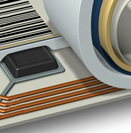An RFID label is a vulnerable thing. As workers toss smart-labeled pallets and cases around in a warehouse or truck, it’s not unusual for a label’s embedded silicon chip to incur electrostatic shock and mechanical damage. In some instances, this translates into sluggish response or limited read range. In a worst-case scenario, valuable data suddenly isn’t available because the label’s transponder has become permanently inoperable.
Appleton, a worldwide market leader of carbonless and thermal papers based in Appleton, Wis., says it has found a way to eliminate the problem. Its SmartStrate label stock, currently undergoing tests, can protect the microchip and promote greater reliability.
“Problems associated with RFID labels can occur at every step within the channel, from manufacturing to end use,” says Vince Reese, business development manager for Appleton. The company’s research shows that RFID label users rank protection from mechanical damage as their biggest need, followed by print quality and protection from the environment (dust, water and so on) and electrostatic shock. “SmartStrate reduces, or in some cases eliminates, the issues that lead to RFID system failure,” he says.
Made with a proprietary cushioned material that is laminated to thermally printable label stock, Appleton’s new label stock enables a transponder’s silicon chip and copper antenna to survive typical environmental hazards. Besides providing physical protection, the cushiony layer dissipates potentially damaging static electricity. Appleton claims that in laboratory testing, RFID microchips on SmartStrate labels functioned normally after receiving discharge voltages three times higher than those that damaged or destroyed microchips on conventional label stock.
In addition, SmartStrate provides a uniformly smooth surface that allows for better quality printing of both human-readable information and bar codes that can be accurately read by scanners. SmartStrate’s cushioning also eliminates the need for the no-print zone typically found on conventional labels. This allows the use of a smaller overall label size, because the entire SmartStrate label surface can be printed on.
In the coming months, products such as SmartStrate could prove a boon in the RFID technology arena, according to Appleton. “As companies make huge investments in RFID infrastructure—including software, middleware and hardware—they will demand that the equipment works effectively,” says Steve McKnight, Appleton’s director of new business development. “These systems will be rendered ineffective, or useless, if the chip can’t be read.”
Surprisingly, none of Appleton’s competitors seem to be addressing this issue. “We have asked the competitive question of our partners and RFID industry players,” says Reese. “Not one has indicated that others are working on this issue. We, of course, have filed two related patent applications to protect our IP.”
Although SmartStrate will add to the cost of RFID labels (the company has not announced final pricing), McKnight believes that the return on investment will justify use of the product. “There is a tremendous value proposition associated with this technology,” McKnight says. “Companies that have used bar code technology will not settle for a significantly reduced number of reads for RFID. SmartStrate will help them achieve positive results.”
The company is presently testing SmartStrate with several large RFID manufacturers and plans to roll out the product in January 2004.


